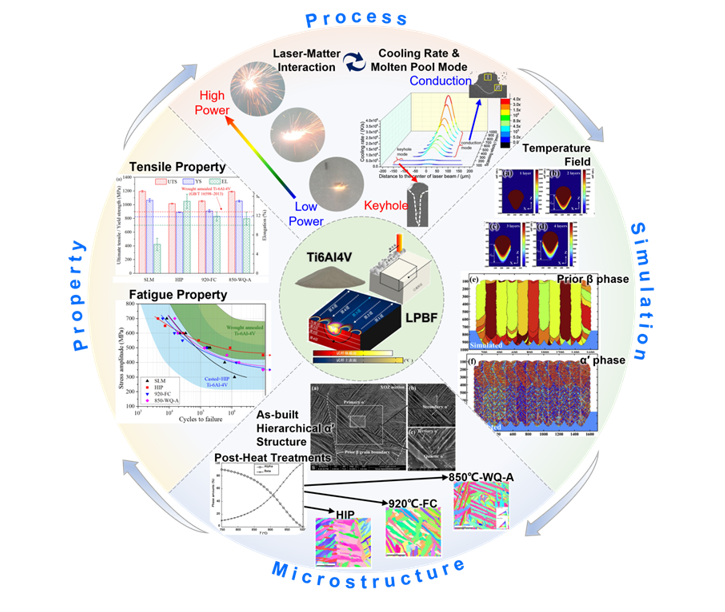Video Article Open Access
Microstructural Evolution during Laser Additive Manufacturing and Tailoring of Mechanical Properties for Applications
Zemin Wang1,*, Jingjing Yang2, Hanchen Yu3, Xiaoyan Zeng4
1Wuhan National Laboratory for Optoelectronics, Huazhong University of Science and Technology, Wuhan, 430074, China
2The Institute of Technological Sciences, Wuhan University, Wuhan, 430071, China
3Wuhan National Laboratory for Optoelectronics, Huazhong University of Science and Technology, Wuhan, 430074, China
4Wuhan National Laboratory for Optoelectronics, Huazhong University of Science and Technology, Wuhan, 430074, China
Vid. Proc. Adv. Mater., Volume 3, Article ID 2208330 (2022)
DOI: 10.5185/vpoam.2022.08330
Publication Date (Web): 19 Mar 2023
Copyright © IAAM
Graphical Abstract

Abstract
Laser additive manufacturing (LAM) opens up a new area for building complex metallic components. But non-equilibrium solidification induced by high-energy laser would experience a subsequent complex heat history involving rapid reheating and cooling cycles due to its layer-wised deposition, which makes the microstructures show unique characteristics and vary for different materials. Thus, it is a big challenge to tailor the mechanical properties for further applications. In this report, the formability, microstructure and evolution mechanism, tailoring of microstructure and mechanical properties of Ti6Al4V alloy fabricated by laser powder bed fusion (LPBF) are studied. There is a wide process window to obtain dense Ti6Al4V alloy samples by combining LPBF parameters. Molten pool mode depends on the input laser energy but does not influence the phase constitute. The peak temperature (TP) and times of thermal cycles are the key factors to microstructural evolution of the as-built Ti6Al4V alloy. Compared with horizontal thermal cycles, vertical thermal cycles play a dominant role on determining microstructural evolution due to that heat mostly dissipates along not horizontal rather vertical direction. The refinement of martensite α′ occurs during vertical thermal cycles of TP > liquid temperature (TL) and is enhanced with thermal cycle times. No obvious microstructural evolution occurs during thermal cycles of TP < TL. Multiple thermal cycles during LPBF depositing cuboid samples are divided into five categories. Different phase transition behaviors will appear in these five thermal cycles, and finally hierarchical martensite structures including primary, secondary, tertiary and quartic α′ martensites within columnar prior β grains are formed. Most α′ martensites show an angle of 45° between major axis and growth direction, whose size can be controlled by varying the LPBF processing parameters. The prediction of microstructure by cellular automaton agrees well with the observed microstructures of single-track, single-layer and multi-layer samples. The tensile (>1100 MPa, >1000 MPa, and 4~7%) and fatigue properties (fatigue cycle number of 104~5 at the stress amplitude of 500 MPa) of the as-built Ti6Al4V alloy are below the level of wrought counterpart due to the fine needle-shaped α' martensite. The mechanical anisotropies depend on the columnar structures rather than the textures or crystal structures, which can be reduced or eliminated by heat treatment or hot isostatic pressing. A tri-modal microstructure including lamellar α, polygonal α and acicular nanoscale α+β phases are formed after 850 ℃ solution treatment and 550 ℃ aging treatment. Their corresponding tensile properties are enhanced to be 1192 MPa, 1054 MPa and 11.4%, which are comparable to those of wrought annealed Ti6Al4V. The microstructure is composed of lamellar α+β phases for the as-built sample after HIP treatment, which improves the tensile (>1000 MPa, >850 MPa, and >10%) and fatigue (105~6 at the stress amplitude of 500 MPa) properties. In summary, novel processing method leads to new properties for the same materials and different post-treatments are required to tailor the microstructure and mechanical properties for different applications.
Keywords
Laser powder bed fusion; Ti6Al4V alloy; microstructure; evolution mechanism; mechanical property.
Acknowledgement
This work is supported by the National Program on Key Basic Research Project of China (973 Program) under Grant No. 613281.
References
- Jingjing Yang, Hanchen Yu, Jie Yin, Ming Gao, Zemin Wang, Xiaoyan Zeng; Materials and Design, 2016, 108, 308.
- Hanchen Yu, Jingjing Yang, Jie Yin, Zemin Wang, Xiaoyan Zeng; Materials Science and Engineering A, 2017, 695, 92.
- Jingjing Yang, Hanchen Yu, Huihui Yang, Fangzhi Li, Zemin Wang, Xiaoyan Zeng; Journal of Alloys and Compounds, 2018, 748, 281.
- Hanchen Yu, Fangzhi Li, Zemin Wang, Xiaoyan Zeng; International Journal of Fatigue, 2019, 120, 175.
- Chenyu Su, Hanchen Yu, Zemin Wang, Jingjing Yang, Xiaoyan Zeng; Journal of Alloys and Compounds, 2021, 857, 157552.
Video Proceedings of Advanced Materials

Upcoming Congress



